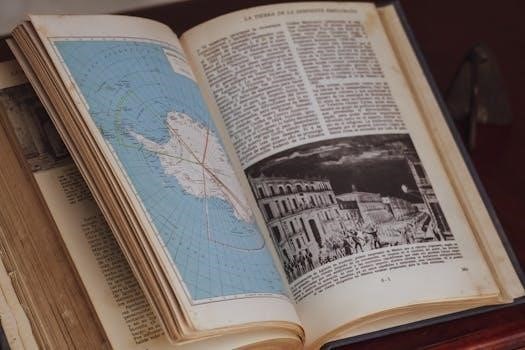

The answer keys for World History Guided Reading Workbooks are essential resources for students and educators. These keys provide solutions to exercises, aiding comprehension and study. They are often found in PDF format for easy access, facilitating effective learning and assessment of historical material.
Overview of Guided Reading Workbooks
Guided reading workbooks, particularly in the context of world history, serve as structured tools designed to enhance student comprehension of complex historical narratives. These workbooks typically accompany a main textbook, offering supplementary exercises, vocabulary support, and reading aids. They are not meant to replace the primary text but rather to facilitate deeper engagement with the material by breaking down large amounts of information into manageable segments. The workbooks may include a variety of activity types, such as fill-in-the-blanks, short answer questions, and matching exercises, all tailored to the specific content of the corresponding textbook chapters. The aim is to improve comprehension, critical thinking, and retention of historical knowledge. Guided reading workbooks are often designed to encourage active learning through note-taking, summarizing, and answering questions that require students to actively process what they have read. This active engagement is crucial in making connections and promoting a more meaningful understanding of world history. Furthermore, the structured nature of these workbooks provides a clear path for students to follow, making it easier to navigate the extensive scope of world history. They also help students practice key skills in history such as identifying main ideas and supporting details.

Purpose of Guided Reading Workbooks
The primary purpose of guided reading workbooks in world history is to enhance students’ understanding and retention of complex historical information. These workbooks are designed to complement the main textbook, not replace it. They aim to break down large chapters into manageable segments, allowing for focused engagement with the material. By including various activities such as vocabulary exercises, fill-in-the-blanks, and short answer questions, workbooks encourage active learning and critical thinking. Another crucial objective is to provide students with a structured approach to studying history, guiding them step-by-step through the content. This structured approach helps students identify key concepts, analyze historical events, and make connections between different periods and cultures. Workbooks also provide a way for students to practice important reading skills. This helps students to engage in active recall which is a key aspect of effective learning. Furthermore, workbooks serve as a tool for self-assessment, enabling students to evaluate their comprehension and identify areas where they may need additional support. Ultimately, the purpose of guided reading workbooks is to foster a deeper, more meaningful understanding of world history.
Key Features of HMH World History Workbooks
HMH, or Houghton Mifflin Harcourt, World History workbooks are known for several key features designed to enhance the learning experience. These workbooks often align directly with their corresponding textbooks, ensuring seamless integration of content. A prominent feature includes varied activity types, such as vocabulary building, map work, and document analysis, to cater to diverse learning styles. Furthermore, these workbooks are structured to promote active engagement with the material, using guided questions and exercises to encourage critical thinking and analysis. Another crucial feature is the modular design, which allows students to focus on specific sections of the curriculum, facilitating a more in-depth understanding. HMH workbooks typically provide clear and concise instructions, making them easy for students to navigate independently. They often include reading aids, summaries, and vocabulary support to assist students with comprehension. These workbooks also emphasize making global connections, encouraging students to think critically about the interconnectedness of historical events. This approach also facilitates active recall which is a key aspect of effective learning. Answer keys are essential components, aiding self-assessment and helping students verify their understanding. Ultimately, HMH workbooks are designed to provide a structured, comprehensive, and engaging approach to learning world history.
Availability of Answer Keys
The availability of answer keys for World History Guided Reading Workbooks is a crucial aspect for both students and educators. These answer keys are typically designed to support the learning process by providing solutions to the exercises and questions found within the workbooks. While some answer keys may be included directly within the teacher’s edition of the textbook, they are often provided as separate resources. These separate keys may be available in various formats, most commonly as a PDF document, which allows for easy distribution and use. The answer keys might also be accessible through online educational platforms or the publisher’s website, often requiring a specific login or access code. It’s important to note that while some answer keys are freely available, others may be restricted to educators or institutions to maintain academic integrity. The availability can also vary depending on the specific edition of the workbook and the publisher. Sometimes, the answer keys are offered as part of a complete package that includes the textbook and workbooks, making them easier to obtain. The presence of an answer key is essential for self-assessment, allowing students to check their work and understand where they may need extra support. They also facilitate teachers in grading and monitoring student progress, making these keys invaluable tools for effective instruction and learning.
Content Coverage in World History Workbooks
World History workbooks, particularly those designed for guided reading, typically encompass a broad spectrum of historical periods and events. These workbooks often start with ancient civilizations, covering regions like Mesopotamia, Egypt, Greece, and Rome, and then progress through the medieval era, examining the rise of various empires and the spread of religions. They delve into the Renaissance and Reformation, exploring the cultural and religious shifts of the time. The content extends to the Age of Exploration, the Enlightenment, and the various revolutions that shaped the modern world. Furthermore, these workbooks cover the Industrial Revolution, the rise of nationalism, and the two World Wars, providing a comprehensive understanding of these critical periods. They also often delve into the Cold War, decolonization, and contemporary global issues. The topics often include political, social, economic, and cultural aspects of history, promoting a holistic understanding of how past events have influenced the present. These workbooks may also feature specific themes or regions, such as the history of Asia, Africa, or Latin America, providing a more nuanced look at global historical events. Therefore, the content coverage is designed to align with standard world history curricula, ensuring students get a well-rounded and detailed education in historical events.
How to Use the Workbook Effectively
To maximize the benefits of a world history guided reading workbook, students should begin by carefully reading the assigned textbook sections. The workbook is designed to complement the textbook, not replace it. Before attempting the exercises, it’s crucial to underline key ideas and information in the textbook, actively engaging with the material. Students should then use the workbook as a tool for reinforcing their comprehension. Answer the questions within each part of the workbook only after a thorough understanding of the corresponding textbook chapter. The workbook often contains varied activities such as fill-in-the-blanks, short answer questions, and mapping exercises which demand active recall, a key aspect of effective learning. Review the lesson summaries and vocabulary support provided in the workbook, paying attention to reading aids, and note-taking suggestions. It’s beneficial to revisit the textbook and workbook sections when facing difficulties to ensure full understanding; For best results, students should use the answer key to review their work and analyze where they made mistakes. This review process helps to identify areas of weakness and allows them to focus on those areas in future studies. Consistent and active engagement with both the textbook and the workbook is the key to success.
Benefits of Guided Reading in History

Guided reading in history offers numerous advantages for students seeking a deeper understanding of the past. It promotes active engagement with historical texts, encouraging students to think critically and make global connections. By providing structured activities, guided reading helps students dissect complex information into manageable parts, enhancing comprehension and retention. The use of workbooks with lesson summaries and vocabulary support aids students in grasping key concepts and terminology, which is crucial for understanding historical context. The interactive nature of guided reading, with its questions and activities, encourages active participation and promotes a more in-depth analysis of events. This approach helps students move beyond passive reading, fostering a deeper engagement with the material. Moreover, guided reading often encourages active recall, a key component of effective learning, helping students to retain information for the long term. It serves as a valuable tool for both teachers and students, facilitating the learning process and making history more accessible. Furthermore, guided reading enables students to develop essential skills such as critical analysis and note-taking which are vital for academic success. Ultimately, it helps students to become more active and informed learners of history.

Textbook Alignment
Guided reading workbooks for world history are specifically designed to align with particular textbooks, ensuring a seamless learning experience. The content within these workbooks directly corresponds to the chapters and sections of their respective textbooks, making it easier for students to follow along and reinforce their understanding. This alignment is crucial for effective learning, as it ensures that the workbook activities complement the material presented in the textbook. The workbooks often include references to specific pages or sections of the textbook, guiding students to the relevant information. This integration helps to avoid confusion and reinforces learning, providing a structured and coherent educational journey. Proper textbook alignment allows students to use the workbook as a tool to enhance their study, rather than a separate entity. The activities and questions in the workbook are carefully crafted to mirror the content and concepts presented in the textbook, facilitating deeper comprehension and retention. This alignment is also beneficial for teachers, as it enables them to easily integrate the workbook into their lesson plans and monitor student progress. In essence, the alignment between the workbook and textbook creates a cohesive learning experience, maximizing the effectiveness of both resources.
Finding Solutions and Answers
Locating solutions and answers for world history guided reading workbooks can be straightforward with the right approach. Typically, these answer keys are available from educational publishers or online platforms. Some publishers provide answer keys as a separate resource, often in PDF format, for teachers or homeschooling parents. These resources may require a specific purchase or be available through a school’s educational portal. Online platforms often offer textbook solutions, including those for guided reading workbooks, which are usually accessible through paid subscriptions or free trials. It’s essential to verify the source’s reliability before relying on any online solutions. Many educational websites and forums can also provide insights and answers, but they might not be comprehensive or fully accurate. When seeking answers, it’s important to ensure they align with the specific edition of the workbook being used as content can vary between editions. Checking the publisher’s official website or contacting their customer support can sometimes lead to the correct answer keys. Engaging with other students or teachers may also prove helpful in finding the necessary solutions, fostering a collaborative approach to learning and problem-solving.
Alternative Resources for Answers
When direct answer keys are unavailable, alternative resources can be invaluable for completing world history guided reading workbooks. Online educational platforms often host forums and study groups where students and educators share insights and solutions. These communities can provide peer-to-peer help and clarify difficult concepts. Additionally, many websites offer textbook solutions and study guides, sometimes providing step-by-step explanations of key historical events and concepts covered in the workbook. Utilizing reputable educational websites, like those associated with universities or academic institutions, can offer more credible information than general search engine results. Library resources, including historical encyclopedias and subject-specific books, can supplement the workbook and aid in understanding. Furthermore, consulting with teachers or tutors may provide personalized assistance and address specific areas of difficulty. Some educational apps and software may also include practice quizzes and review materials based on world history topics, which can reinforce learning and help assess comprehension. By combining these diverse resources, students can gain a more thorough grasp of the material and effectively complete the guided reading exercises, even without a specific answer key.
Specific Editions and Publishers
World history guided reading workbooks are published by various educational companies, each with its own specific editions catering to different curricula and learning objectives. Houghton Mifflin Harcourt (HMH) is a prominent publisher, known for its comprehensive world history programs, including guided reading workbooks and answer keys. These HMH workbooks often align with their respective textbooks, such as “Modern World History⁚ Patterns of Interaction”. Other publishers, like Saxon Publishing, also offer workbooks and answer keys for world history, sometimes focusing on specific historical periods or themes. It is essential to identify the exact edition and publisher of the workbook to ensure the correct answer key is used. Mismatched editions can lead to confusion and inaccurate answers. Some editions might be tailored to specific state standards or educational frameworks, making it crucial to verify compatibility. Always check the ISBN (International Standard Book Number) of the workbook to accurately find the corresponding answer key. Additionally, online marketplaces and educational retailers often list workbooks by publisher and edition, making it easier to locate the necessary materials. Using the correct edition and publisher ensures that students are using the appropriate resources for their learning objectives.